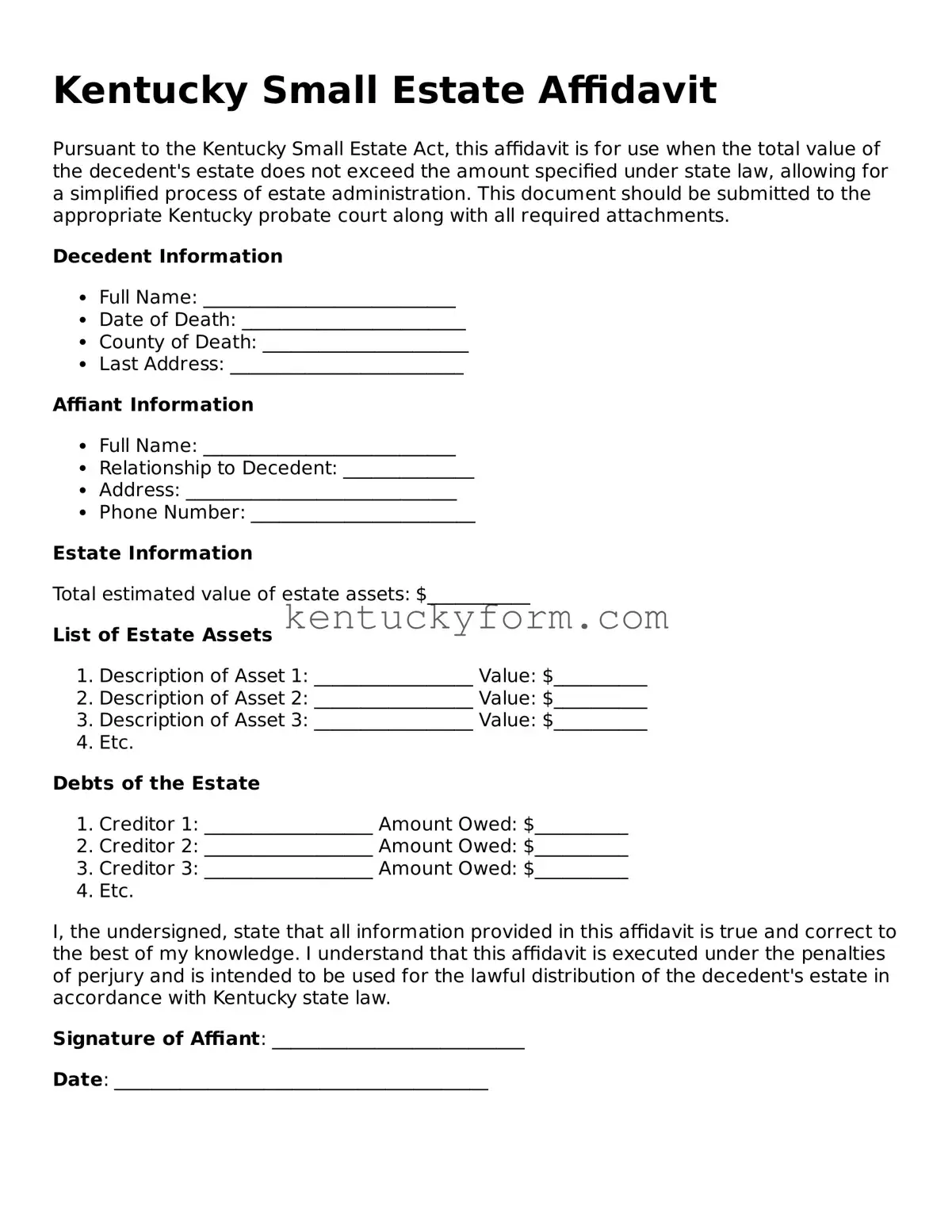The Kentucky Small Estate Affidavit form shares similarities with the Affidavit for Collection of Personal Property in California. Both serve to facilitate the transfer of the decedent's property to their rightful heirs without the need for a full probate process. These affidavits are used in situations where the deceased person’s estate is below a certain value threshold, thereby simplifying the legal proceedings necessary to distribute the assets of the deceased.
Similar to the Kentucky Small Estate Affidavit form is the Texas Affidavit of Heirship. This document is also designed to expedite the transfer of property from a decedent to their heirs, particularly when the estate consists mostly of real property. Both forms require the attestation to facts regarding the deceased and their heirs, though the specific legal requirements and details may vary between Kentucky and Texas law.
The Small Estate Administration Form, as used in New York, parallels the Kentucky Small Estate Affidavit in its objective to streamline the estate settlement process for small estates. Both documents enable the heirs to avoid the lengthy and complex probate process, provided the value of the estate falls under the legally specified limit. The main difference lies in the procedural requirements and the maximum value of the estate that qualifies for this simplified process in each state.
Illinois's Small Estate Affidavit also mirrors Kentucky's version, aiming to simplify the process of asset distribution. Both forms are beneficial in instances where the deceased did not leave a vast amount of property behind. They allow for the distribution of the assets to the heirs or legatees quickly, assuming the total value of the estate does not exceed state-specific caps.
The Affidavit for Transfer of Personal Property without Probation in Arizona shares goals with Kentucky’s equivalent, in easing the process of transferring assets to beneficiaries. Both documents bypass the more lengthy probate proceedings by certifying that the estate in question falls below a certain monetary threshold. The specifics of this threshold and the types of assets that can be transferred in this manner may differ.
Similar in purpose to the Kentucky Small Estate Affidavit is Florida's Disposition of Personal Property without Administration. This document is used when the deceased’s estate consists primarily of personal property and is of low value. Both documents aim to relieve the burden on the family members of the deceased by providing a quicker, more straightforward way to distribute the assets without undergoing a full probate process.
Colorado’s Small Estate Affidavit stands in resemblance to Kentucky’s, as both are designed for the collection and distribution of the deceased's property under a simplified legal process. These affidavits are particularly useful when the decedent's estate does not include real estate and consists of assets below a certain value, facilitating an expedited transfer to heirs or designated beneficiaries.
The Small Estate Affidavit used in Michigan has similarities to Kentucky's affidavit, with both intending to streamline the process of settling small estates. They offer a procedural shortcut that can significantly reduce the time and paperwork required to distribute the deceased's assets to their rightful heirs, pending the estate falls under a specified value limitation set by the respective state law.
Ohio’s Summary Release from Administration is another document that bears resemblance to the Kentucky Small Estate Affidavit. It is designed for the swift handling of estates that are small in value, allowing for a quick resolution and distribution of assets to beneficiaries. Both documents enable a simplified process for estates that meet the criteria, such as a low total value and the absence of real estate within the estate.
Lastly, the Voluntary Administration Statement, as utilized in Massachusetts, shares the streamlined approach of the Kentucky Small Estate Affidavit for handling small estates. Both facilitate an easier transition of assets to the decedent’s heirs or legatees, markedly when the estate does not hold significant value. This simplification helps families navigate the legal system more smoothly during a difficult time of loss.
